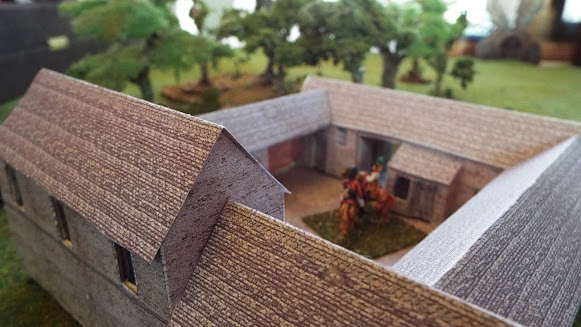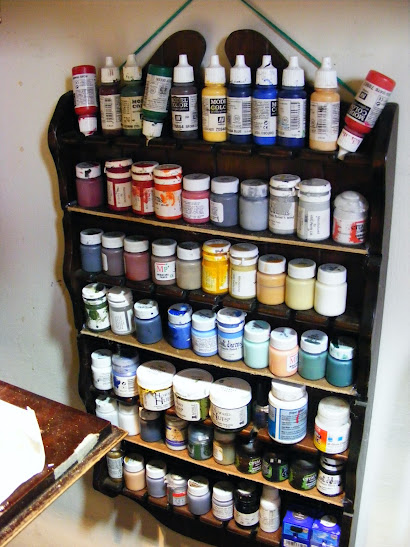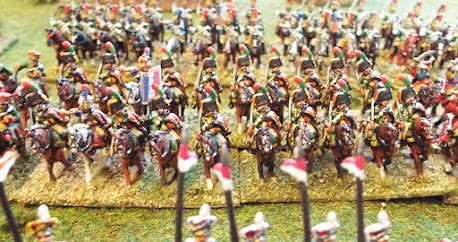Aide de Camp
"I don't care if you are in a hurry monsieur!"
Tuesday 9 February 2021
Cardstock buildings
Monday 1 February 2021
MATERIALS
Paints
Brushes
Pens.
Other Materials.
 |
| Austrian Staff |
 |
| Bonaparte, Staff and Bodyguard |
Changing Tastes
I painted these lancers about 30 years ago. At the time, I liked the style of the Old Glory figures and other 18mm figures as opposed to the true 15mm ones partly because of the detail and partly because of the variety in the poses of figures. However, as the ranges increased, so too did the scale and the exaggeration of poses.
Maybe it's an age thing -nostalgia for a less commercialized era of wargaming, but I've now reverted to the older, more regimented style of figures. Apart from anything else they tend to be cheaper. What many gamers don't seem to realise is that you don't need top price figures if the paint job is right, but get it wrong and even the best miniatures look rotten.
I'm now rebuilding my collection around some practically antique Heritage/Empire miniatures I've had for donkey's years. I've stripped them down to bare metal, drilled out hands with broken swords and lances and replaced them with staples and "Liquid Green Stuff" They look good as new now. The Austrians will be part of my "Army of Bohemia" and the French will become Neapolitan infantry when I get them sorted.
I don't suppose I'll ever let anyone see this record, but if I do, it's an attempt to pass on a bit of practical advice on preparing for games rather than actually playing them -painting figures, constructing scenery, some ideas on rules, increasing "fog of war" in games (something I love!) and campaigns.
Hopefully, I will be able to show how anyone can turn out an army and table to be proud of.
At it's peak, my collection reached over 10,000 figures, but as other gamers were always asking if they could buy whatever unit and I could never say no, I must have painted 100s of 1000s of figures over the years. I've probably used just about every make of figure there is at one time or another too.
Follow the simple methods I show to end up with results as good as those on my photos. I know I'm not the World's greatest painter or scenery builder, but what I can show is achievable by all.
 |
| Restored Heritage Austrian Hussars |
 |
| Lancashire Games Austrian generals |
WHEN I WERE A LAD
Hi.
My Name is Mal.
I have been playing with toy soldiers (ducks the eggs and rotten tomatoes) for practically as long as I can remember. I never was a closet wargamer. I was self "outed" from the start and feel a bit sorry for those who still feel that being a gamer is cause for embarrassment or shame. I think I was about 12 years old when the “Waterloo” film came out and the school book club had as it's quarterly special, the book of the film and another titled “The Uniforms of Waterloo” or some such. I forget exactly as the book sold out and I never received a copy. My interest was piqued anyway and the film confirmed my new addiction. A short while after, I went into town -Scunthorpe- and bought myself a copy of a wonderful book (in French Zut Alors!) titled “L'Uniforme Et Les Armes Des Soldats Du Premier Empire” by L and F Funken, which with my schoolboy French and the assistance of a French mistress, (French mistress, not French Mistress) I could just about make out.
My friends and I began with armies of Airfix highlanders and cuirassiers bolstered by Guards Colour Parties and ACW figures with blobs of wood filler on their heads as shakos. Then we discovered 20mm Miniature Figurines. I collected French, one of my mates the Brits and another the Prussians. We played using Donald Featherstone rules copied by hand out of a library book. Funnily, another group in school were playing ACW, again using Airfix and they declared that Napoleonics wasn't proper wargaming -only ACW. I never did get to play ACW. Except for the odd naval disaster. not out of any other reason than that I prefer the LOOK of Napoleonic figures. Apart from that, I always found myself more interested in our own history than that of the Americans.
I suppose it was my love of history that led me into wargames and the wargames that led me to look deeper into history. There seems to be the same kind of split between the players of the many rule sets available today as that between my school mates and us -a bit like the Reb and Yankee re-enactors that turn up at the "Triples" in Sheffield every year. I've tried most periods, put on big WW2 display games and even dabbled a bit with Sci-Fi and fantasy (not GW though) and even written rules for some- including a set called "Dogface" set in Vietgnome -and firmly believe that playing any wargame is better than none, but never ACW. Daft isn't it. My great love has always been Napoleonic gaming and it is to that I have always returned.
The games of today are pretty different to those we started with all those years ago and even those I played during my last bout of the fever. They seem simpler now. "With a Napoleonic flavour" seems more popular than actual "history." Almost "dumbed down," with a concentration more on slick presentation rather than innovation and I do feel that the ubiquitous Games Workshop, having entered the historic games scene through the Perry twins and others, have taken away some of the chaotic individuality, inventiveness and drive of an earlier era. On the other hand, scenery tends to be better now! What I would like to see wargamers aspire to is the kind of quality of scenery regularly seen on good model railway layouts. I realize there is a difference in the durability required but it's possible to come at least close.
A lot of my approach to gaming has been coloured by various places asking my friends and I to put on display or participation games and the effort I expend on getting the figures looking as good as I can. Between these, they have led me to a belief that the table upon which the game is played is as important to the hobby as the game itself. The whole aesthetic is a vital a part of the game as the rules used. I can't get into something played on a bare table with a few bits of card marking hills, towns etc. They lack ambiance and if I can't get down amongst the troops on the table the whole thing seems almost pointless.
Being on a pretty tight budget for most of my gaming life, I've had to be inventive in the construction of scenery and terrain features that looked as good as my limited modelling skills allow. To that end, I intend for this blog to be about constructing all sorts of features vital to a good game and to point the novice gamer, both historic and fantastic to sources of materials and items as cheaply as possible. Most will be in my own chosen scale (15-18mm) but should be easily altered to suit other scales. Don't expect perfection in my work, time and arthritis now preclude that, what I'm aiming at is more a sharing of ideas, methods and resources.
Over the years, I've gone through periods where wargames weren't part of my life, but they are, (unfortunately perhaps) rather like malaria -once it gets into your blood you're stuck with it. You can go for years without playing or painting, but then, one day, something will set off another attack. It can be anything, a film, book, question on a quiz show, somewhere you've visited and before you know where you are, your fingers are twitching towards paintbrushes and dice and it's back as bad as it ever was. There's no cure so you might as well just get painting and enjoy it!
Cheers
Mal






































